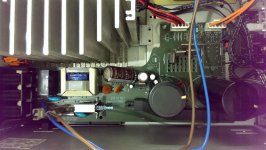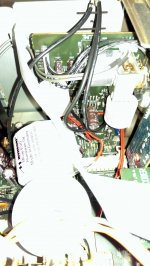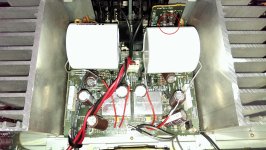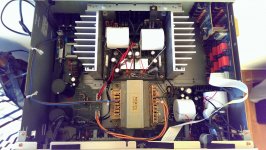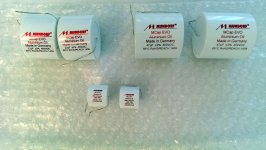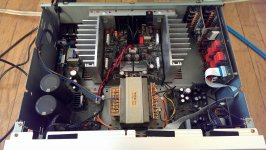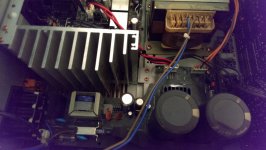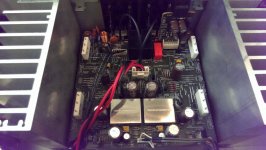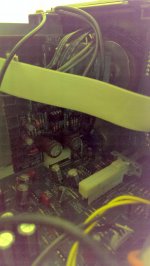I've fitted the 22µF (2661 & 2662) caps by the end of the afternoon.
Everything I wanted to do is now done.
I don't know if it would have been different beginning with this one, but wow. This last caps are giving a big improvement. Everything sound better now, from low to high freq.
Thanks McGyver for your advices !
Everything I wanted to do is now done.
I don't know if it would have been different beginning with this one, but wow. This last caps are giving a big improvement. Everything sound better now, from low to high freq.
Thanks McGyver for your advices !
Hi,
if anyone happens to read this, I need some advice.
For some times, I noticed a small noise coming from my speakers.
I was thinking it could be a ground loop, but I've tried to learn more about those, and noticed, it should not be that, because, the noise level is the same, whatever the volume pot on my amp is set at.
And that's when I also noticed, there was the same noise coming from my amp.
And touching it, I then discovered it was vibrating.
What should I do ?
if anyone happens to read this, I need some advice.
For some times, I noticed a small noise coming from my speakers.
I was thinking it could be a ground loop, but I've tried to learn more about those, and noticed, it should not be that, because, the noise level is the same, whatever the volume pot on my amp is set at.
And that's when I also noticed, there was the same noise coming from my amp.
And touching it, I then discovered it was vibrating.
What should I do ?
It appears from the service manual that your amplifier is ungrounded and has just a 2 wire mains connection. That makes it particularly hazardous at 230V, whether double insulated or not. Never work on such an amplifier whilst it is powered unless you use a proper mains isolation transformer.
This is also a part class A design - up to 25W anyway. That means it draws quite a bit a of steady bias current, perhaps 1.5 amps per channel constantly, before it levels off and only the signal peaks require higher current. This is what causes transformers to hum.
You have a class A/AB switch, so first change between them and see what happens to the hum, if anything.
This is also a part class A design - up to 25W anyway. That means it draws quite a bit a of steady bias current, perhaps 1.5 amps per channel constantly, before it levels off and only the signal peaks require higher current. This is what causes transformers to hum.
You have a class A/AB switch, so first change between them and see what happens to the hum, if anything.
Yes, my bad - I blame the poor and blurred schematic!
However, the situation remains, assuming this is a clearly audible noise from say, 2 metres distance.
Most mechanical noise only has a few sources; first the transformer, then electrolytic caps that may be drying out or even a relay may be being fed AC current or something silly like that.
Using the schematic instructions for setting bias, check it with a digital multimeter and also measure the main DC power supply voltages. Check against the manual instructions. If you also have insulated clip leads to attach the probes, you can measure more safely as you test the supply when music is playing at moderate level. The main supplies should not drop more than a volt or so in this situation. If you hear a change in the buzzing as power is increased, there still could be other problems but most likely, the large capacitors need replacement.
Take great care where you place your hands, if you are new to electronics. The transformer is the only thing between you and lethal mains power.
However, the situation remains, assuming this is a clearly audible noise from say, 2 metres distance.
Most mechanical noise only has a few sources; first the transformer, then electrolytic caps that may be drying out or even a relay may be being fed AC current or something silly like that.
Using the schematic instructions for setting bias, check it with a digital multimeter and also measure the main DC power supply voltages. Check against the manual instructions. If you also have insulated clip leads to attach the probes, you can measure more safely as you test the supply when music is playing at moderate level. The main supplies should not drop more than a volt or so in this situation. If you hear a change in the buzzing as power is increased, there still could be other problems but most likely, the large capacitors need replacement.
Take great care where you place your hands, if you are new to electronics. The transformer is the only thing between you and lethal mains power.
Hello, I was browsing web about a Marantz PM78 tweaking when I found your thread about PM68.
I need to replace power caps on my old PM78 and I know that power caps are the same of the PM68.
Since I don't want to dismantle my amplifier before to be sure to have found the right components, please, can you tell me, original 12000 uF 63 V caps have two, three or four legs eachs?
How many difficult has it been mounting Mundorf M-Lytic, which are two legs type? I'm going to buy 15000 uF 63 V but I'd want to be sure before..
Thanks in advance!
Andrea
I need to replace power caps on my old PM78 and I know that power caps are the same of the PM68.
Since I don't want to dismantle my amplifier before to be sure to have found the right components, please, can you tell me, original 12000 uF 63 V caps have two, three or four legs eachs?
How many difficult has it been mounting Mundorf M-Lytic, which are two legs type? I'm going to buy 15000 uF 63 V but I'd want to be sure before..
Thanks in advance!
Andrea
Hi Andrea,
The original caps have 4 legs each.
The Mundorf M-Lytic have 2 legs each.
The pcb has 4 holes : 2 useful ones, and 2 useless one, only there to help it stay firmly attached i guess.
I put one leg in one of the useful hole and the other one, since the 2nd useful log was too far, I put it in one of the 2 other mounting hole, and added a small piece of wire to connect it to the 2nd useful hole.
The original caps have 4 legs each.
The Mundorf M-Lytic have 2 legs each.
The pcb has 4 holes : 2 useful ones, and 2 useless one, only there to help it stay firmly attached i guess.
I put one leg in one of the useful hole and the other one, since the 2nd useful log was too far, I put it in one of the 2 other mounting hole, and added a small piece of wire to connect it to the 2nd useful hole.
Marantz PM68
Hello everyone! This is my first post here.
I have a gold PM-68 amplifier since 1997. A few years ago it suddenly stopped powering up. Before giving it for service i decided to do all the recommended mods our fellow member McGyver recommended in his posts and in addition i replaced the rest of the capacitors in these 3 boards. Power board, volume board and main amp board.
Power Board: I started by replacing GBU6D with 4 ultra fast soft recovery diodes HFA08TB60. The two large capacitors where replaced with 15000uF 63V Mundorf Mlytic AG. A group of 4 capacitors next to the diode bridge where replaced with same values elna silmic2.
Volume Board: Replaced the opamp with OP275. Replaced 2.2uF and 22uF elna cerafines with same values Mundorf MCap Evo Oil 450V.
Replaced rest of capacitors with same values elna silmic2.
Main Amp Board: A pair of 47uF in signal path on output replaced again with same capacitance Mundorf MCap Evoi Oil 350V. Every other capacitor replaced with elna silmic2 same values.
After all that work the amplifier either: powers up normally but nothing is heard unless i fully turn up the volume and place my ear next to the speaker OR it doesn't power up and just a little buzz is heard for 1sec somewhere in the power circuit, at the back near the small transformer.
Any thoughts before i give it to a specialist?
P.S. I red somewhere that the capacitors on the little board that i circled in red in my last pic, often need to be replaced because after a few years they fail and the amplifier refuses to turn on. Don't know if this is related here.
Hello everyone! This is my first post here.
I have a gold PM-68 amplifier since 1997. A few years ago it suddenly stopped powering up. Before giving it for service i decided to do all the recommended mods our fellow member McGyver recommended in his posts and in addition i replaced the rest of the capacitors in these 3 boards. Power board, volume board and main amp board.
Power Board: I started by replacing GBU6D with 4 ultra fast soft recovery diodes HFA08TB60. The two large capacitors where replaced with 15000uF 63V Mundorf Mlytic AG. A group of 4 capacitors next to the diode bridge where replaced with same values elna silmic2.
Volume Board: Replaced the opamp with OP275. Replaced 2.2uF and 22uF elna cerafines with same values Mundorf MCap Evo Oil 450V.
Replaced rest of capacitors with same values elna silmic2.
Main Amp Board: A pair of 47uF in signal path on output replaced again with same capacitance Mundorf MCap Evoi Oil 350V. Every other capacitor replaced with elna silmic2 same values.
After all that work the amplifier either: powers up normally but nothing is heard unless i fully turn up the volume and place my ear next to the speaker OR it doesn't power up and just a little buzz is heard for 1sec somewhere in the power circuit, at the back near the small transformer.
Any thoughts before i give it to a specialist?
P.S. I red somewhere that the capacitors on the little board that i circled in red in my last pic, often need to be replaced because after a few years they fail and the amplifier refuses to turn on. Don't know if this is related here.
Attachments
This ugly hack job beautifully illustrates why mechanics should be taken into account when performing mods. I would not be overly surprised if those big honkin' Mundorf caps on the amplifier board with their loooooong leads were the problem. Ever heard of parasitic inductance? Even if that is not the problem, leads and cap cover a major part of the circuit, and I wouldn't be overly surprised if that resulted in unwanted capacitive coupling and hence oscillation. (Either that, or you provoked some previously dodgy solder joints, or messed up somewhere else like at the opamp or forgot plugging some cable back in or whatnot. Some workshops will not even work on devices that have previously been tinkered with, as fault-finding can be lengthy and tedious.) It looks ridiculous to boot.
I have no idea what people always want with those boutique Mundorf caps. A 47µ/350V like that might belong in a speaker crossover, but not in an amplifier. I'm not sure what this cap does, but if it's the input coupling cap, with that kind of value it was generously oversized to begin with, and a nice low-leakage type would have made a good replacement while not covering half the board.
BTW, OP275 is rather a downgrade from NJM2114.
I have no idea what people always want with those boutique Mundorf caps. A 47µ/350V like that might belong in a speaker crossover, but not in an amplifier. I'm not sure what this cap does, but if it's the input coupling cap, with that kind of value it was generously oversized to begin with, and a nice low-leakage type would have made a good replacement while not covering half the board.
BTW, OP275 is rather a downgrade from NJM2114.
Those 47uf on output are bias stability capacitors and those Mundorf are way to much for that purpose.Main Amp Board: A pair of 47uF in signal path on output replaced again with same capacitance Mundorf MCap Evoi Oil 350V. Every other capacitor replaced with elna silmic2 same values.
Replace all of big Mundorfs in signal path with Elna silmic 2 and Elnas in power supply whit panasonic fc or similar good type of capacitors for power line.
Yes, i thought of that too. I will replace all Mundorfs with Elnas as it was before and leave diode bridge and opamp as it is for the time being. Already removed the Mundorfs and are up for sale if anyone is interested. New with receipt of purchase etc.
Attachments
Yes, i thought of that too. I will replace all Mundorfs with Elnas as it was before and leave diode bridge and opamp as it is for the time being. Already removed the Mundorfs and are up for sale if anyone is interested. New with receipt of purchase etc.
If you have warm mudded sound then try nichicon muse es and silmic 2 combination.
Some things that i have sorted out. First of all i found that the power switch was moving a bit so i re-soldered the connections. This explains why sometimes it turned on and others it didn't.
Then i noticed that the flat cable that connects the inputs board with the front panel was connected the other way round. I had already removed the Mundorfs so i'll never know if it played or not but i'm pretty sure this explains why i didn't hear anything from the speakers unless i turned up the volume all the way up.
Anyway, all Mundorfs are already replaced with Silmics II and my only concern know is the power board main filter caps. Originally it had two 12000uF/63V ELNA's For Audio which are not produced anymore. There are some on e-bay but i'm pretty sure they are fake as they are not listed in Elna's product catalogue.
Options for this capacitance are very limited and probably not worthy. I am considering Nichicon KG either 10000uF or 15000uF. 15000 would be the safer choice but then again i wouldn't like to spend much since i already messed up buying the Evo Oils. Considering this thing drives 8Ohm speakers in its rated 95W output power, would it be too risky to fit the 10000uF caps?
Then i noticed that the flat cable that connects the inputs board with the front panel was connected the other way round. I had already removed the Mundorfs so i'll never know if it played or not but i'm pretty sure this explains why i didn't hear anything from the speakers unless i turned up the volume all the way up.
Anyway, all Mundorfs are already replaced with Silmics II and my only concern know is the power board main filter caps. Originally it had two 12000uF/63V ELNA's For Audio which are not produced anymore. There are some on e-bay but i'm pretty sure they are fake as they are not listed in Elna's product catalogue.
Options for this capacitance are very limited and probably not worthy. I am considering Nichicon KG either 10000uF or 15000uF. 15000 would be the safer choice but then again i wouldn't like to spend much since i already messed up buying the Evo Oils. Considering this thing drives 8Ohm speakers in its rated 95W output power, would it be too risky to fit the 10000uF caps?
example of how NOT to upgrade an amp.
Exactly! this is again an example of how many amps are waisted in the upgrade process. I had quite some amps here that I had to restore from a bad upgrade. Very expensive Luxmans, Sony's with huge caps as "upgrade" the amp was OF COURSE oscilating badly: again no knowledge problems!
This ugly hack job beautifully illustrates why mechanics should be taken into account when performing mods. I would not be overly surprised if those big honkin' Mundorf caps on the amplifier board with their loooooong leads were the problem. Ever heard of parasitic inductance? Even if that is not the problem, leads and cap cover a major part of the circuit, and I wouldn't be overly surprised if that resulted in unwanted capacitive coupling and hence oscillation. (Either that, or you provoked some previously dodgy solder joints, or messed up somewhere else like at the opamp or forgot plugging some cable back in or whatnot. Some workshops will not even work on devices that have previously been tinkered with, as fault-finding can be lengthy and tedious.) It looks ridiculous to boot.
I have no idea what people always want with those boutique Mundorf caps. A 47µ/350V like that might belong in a speaker crossover, but not in an amplifier. I'm not sure what this cap does, but if it's the input coupling cap, with that kind of value it was generously oversized to begin with, and a nice low-leakage type would have made a good replacement while not covering half the board.
BTW, OP275 is rather a downgrade from NJM2114.
Exactly! this is again an example of how many amps are waisted in the upgrade process. I had quite some amps here that I had to restore from a bad upgrade. Very expensive Luxmans, Sony's with huge caps as "upgrade" the amp was OF COURSE oscilating badly: again no knowledge problems!
Exactly! this is again an example of how many amps are waisted in the upgrade process. I had quite some amps here that I had to restore from a bad upgrade. Very expensive Luxmans, Sony's with huge caps as "upgrade" the amp was OF COURSE oscilating badly: again no knowledge problems!
Alright, lesson learned. Enough of the criticism.
Everything is back in it's original state now. Any suggestions regarding what i asked?
PM68 Restored
Ugly hack job now gone.
I really liked its original sound so i tried to preserve its character by using mostly ELNA. Of course, any improvements are welcome.
Starting from the power board: Original filter caps ELNA For Audio 12000uF 63V replaced with Nichicon KG Gold Tune 15000uF 63V. Bridge rectifier 6A 200V GBU6D replaced with 8A 400V GBU8G just to give it some air. Rest of lytics (group of 4) replaced with SILMIC II (same values).
Main Board & Speaker protection board: Every cap replaced with SILMIC II (same values).
Volume Board. Cerafines and ELNAS all replaced by SILMIC II (same values). 8pin DIP socket installed and fitted a new NJM2114D.
I also purchased the following opamps for testing
OPA2604
OPA2132
LM4562/LME49720
First Impressions. After a few hours of listening i find it a little underpowered. It used to be more linear and dynamic when i turned up the volume showing gains in all frequencies. Now, it somehow flattens out from some point and after and maybe it is a little less punchy or precise.
I am reading everywhere that silmics require quite a lot of break in hours. At least 50 or more. Something else that is new territory for me are the main Nichicon caps. Don't know how much they contribute to what i hear but they certainly cant be worse than the old ELNAS in all respects.
Lastly i am willing to test the other opamps and hear for any differences. But all that after the break in period right?
Anyway, that's all. Anyone having something to add or recommend i will be happy to read.
Ugly hack job now gone.
I really liked its original sound so i tried to preserve its character by using mostly ELNA. Of course, any improvements are welcome.
Starting from the power board: Original filter caps ELNA For Audio 12000uF 63V replaced with Nichicon KG Gold Tune 15000uF 63V. Bridge rectifier 6A 200V GBU6D replaced with 8A 400V GBU8G just to give it some air. Rest of lytics (group of 4) replaced with SILMIC II (same values).
Main Board & Speaker protection board: Every cap replaced with SILMIC II (same values).
Volume Board. Cerafines and ELNAS all replaced by SILMIC II (same values). 8pin DIP socket installed and fitted a new NJM2114D.
I also purchased the following opamps for testing
OPA2604
OPA2132
LM4562/LME49720
First Impressions. After a few hours of listening i find it a little underpowered. It used to be more linear and dynamic when i turned up the volume showing gains in all frequencies. Now, it somehow flattens out from some point and after and maybe it is a little less punchy or precise.
I am reading everywhere that silmics require quite a lot of break in hours. At least 50 or more. Something else that is new territory for me are the main Nichicon caps. Don't know how much they contribute to what i hear but they certainly cant be worse than the old ELNAS in all respects.
Lastly i am willing to test the other opamps and hear for any differences. But all that after the break in period right?
Anyway, that's all. Anyone having something to add or recommend i will be happy to read.
Attachments
- Status
- This old topic is closed. If you want to reopen this topic, contact a moderator using the "Report Post" button.
- Home
- Amplifiers
- Solid State
- Marantz PM68 tweak
